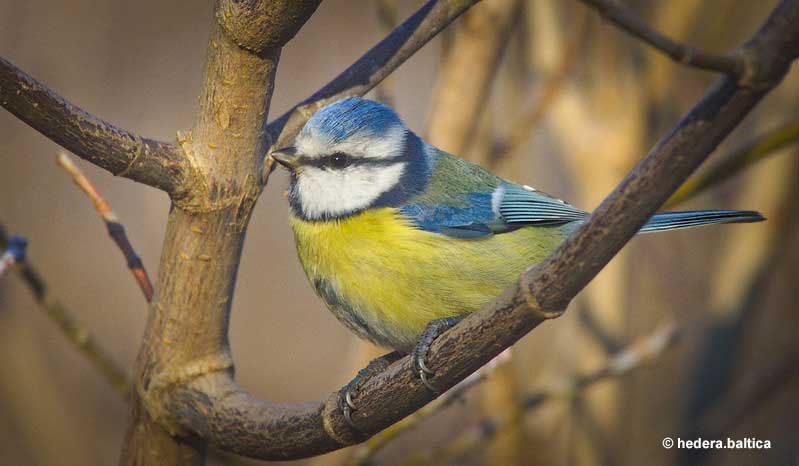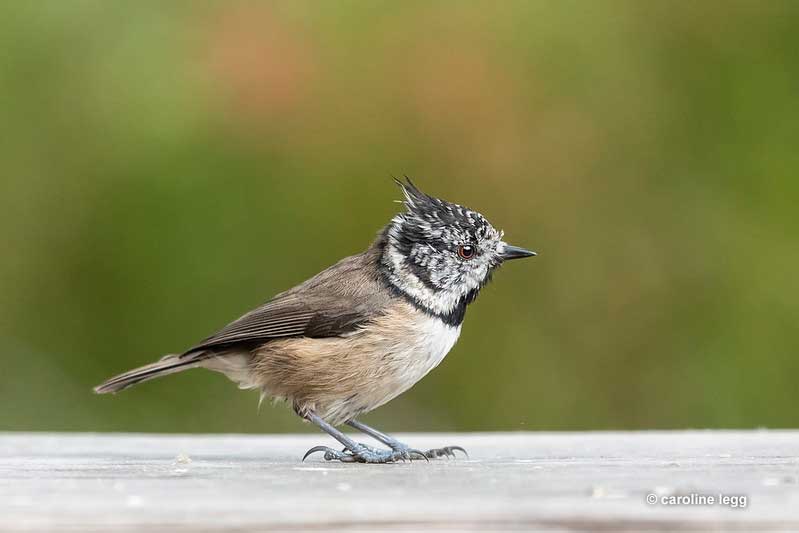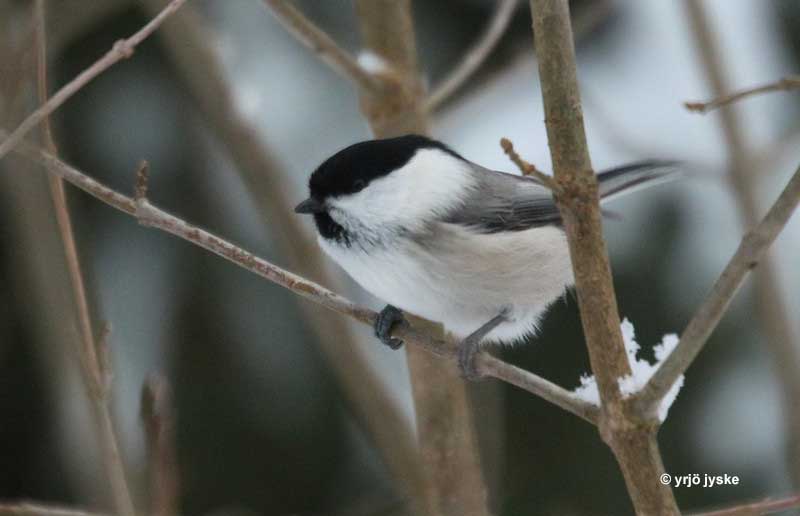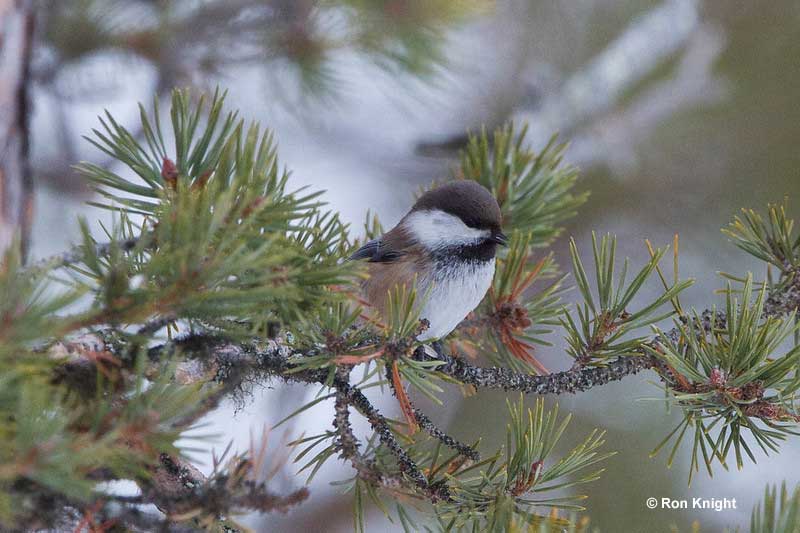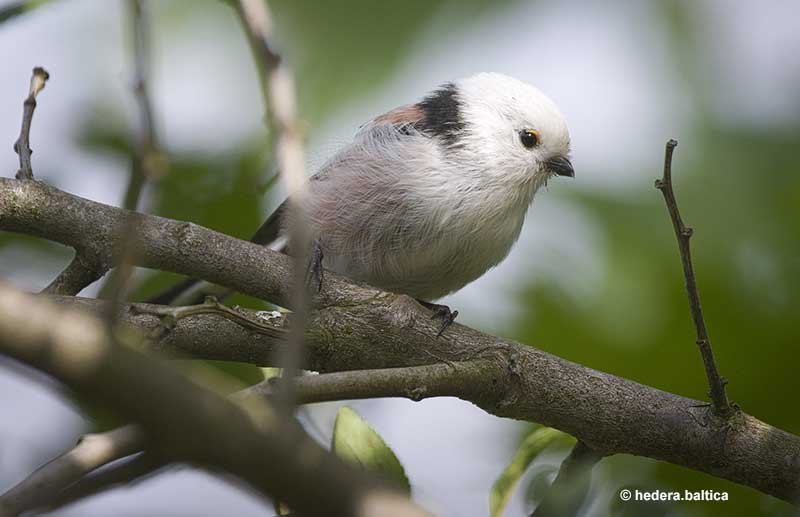
Tits (the birds) are largely associated with Eurasian species – the Great Tit for example. But in reality, the birds we know as chickadees and titmice belong to the same family.
And let’s be honest, they are some of the cutest birds on the planet. No matter where you live, these common birds entertain us with endearing, friendly attitudes, and adorable appearances.
But are the species any different? How many members of this bird family live in North America?
Key takeaways:
- Tits are known as chickadees and titmice in the U.S. Their relatives behind the ocean are usually called tits.
- They all belong to the Paridae family, which, in turn, is related to swallows, crows, and flycatchers!
- One trait that all tits share is their adorable collection of songs and calls.
On this page
Common Eurasian Species (aka The ‘True Tits’)
Great Tit
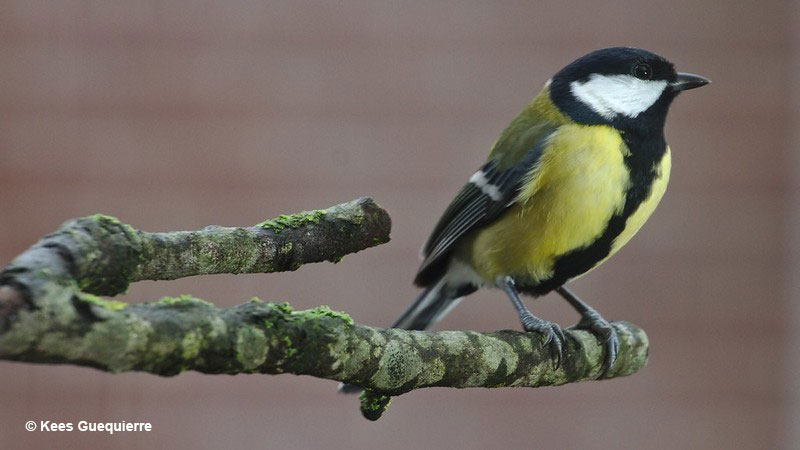
Scientific name: Parus major
Size: 5.5 inches
Habitat: Various woodland habitats, parks, and gardens.
The Great Tit is a fairly large and colorful tit species with a prominent white face patch on its black head. It also has a black throat and a thick black line that extends down the front of its dingy yellow underparts.
Related: Funny bird names that make you take another look
This tit bird has a small pale patch on the back of its head, a green back, and bluish wings with one white wing bar. It also has a bluish tail and white undertail.
Both sexes of the Great Tit look similar, but females are duller and have less black on their underparts.
These small tits forage with other small birds in bushes and trees to look for larvae and all sorts of insects. In fall and winter, they also eat a lot more seeds and often visit bird feeders.
Great Tits are common birds throughout Europe, some parts of North Africa, and in some areas of central Asia.
Eurasian Blue Tit
Scientific name: Cyanistes caeruleus
Size: 4.72 inches
Habitat: Deciduous woodlands, parks, and big gardens.
The Eurasian Blue Tit is a beautiful little bird with a blue cap and broad white eyebrow that meets above the bird’s beak and on the back of its head. It also has a white face with a black border, narrow black line through its eyes, and a small black throat patch.
The rest of its underparts are yellow with a small black patch, and its back is dull green. The Blue Tit’s wings are blue with one white wing bar, and it has a blue tail.
Eurasian Blue Tits mostly forage for small insects and larvae in the foliage and trees and bushes. However, they also take berries and frequently visit bird feeders for seeds and scraps of food. While foraging, this species usually occurs in flocks, often with other small birds.
Eurasian Blue Tits are common birds throughout Europe and parts of western Asia. In many areas, they have become adapted to living with people in gardens and parks.
Crested Tit
Scientific name: Lophophanes cristatus
Size: 4.72 inches
Habitat: Coniferous woodlands.
Crested Tits are small, warbler-sized birds with a prominent mottled black and white crest. They have a white face with a narrow black border on the back part of it, and a narrow black line going back from their eyes.
These neat little birds also have a black throat patch, and a black beak slenderer than the stubby bills of other tit species. The rest of the upperparts of the Crested Tit are brown and their underparts are white with pale tan sides.
Female Crested Tits greatly resemble males but have slightly shorter crests and slight differences in the plumage patterns on their heads.
Pairs or small groups forage for insects, berries, and seeds by picking food from foliage and branches. They can also join flocks with other species and occasionally visit bird feeders.
Crested Tits are fairly common in large parts of Europe and western Russia but, in the United Kingdom, are restricted to the Scottish Highlands.
Willow Tit
Scientific name: Poecile montanus
Size: 4.72 inches
Habitat: Coniferous forests and woodlands next to wetlands.
Willow Tits are small, warbler-sized birds with a sooty black cap, large white face patch, and a smallish black throat patch. They have a stubby but sharp black beak, pale brown-gray upperparts, and pale, tan and white underparts.
These small tits also have a bit of white edging on their gray wings and tails, and both sexes of the Willow Tit look the same.
These small birds actively forage in trees and bushes for a wide variety of insects and larvae. They also eat various berries and seeds, and often act as the nucleus of mixed feeding flocks.
On occasion, these tit birds also visit bird feeders but not as much as some other members of their family.
Willow Tits are fairly common birds in many parts of Europe, central Asia, and Japan. In the United Kingdom, unfortunately, habitat loss has caused the Willow Tit to decline and disappear from many areas.
Tit Species in North America (Or The So-Called Distant Relatives)
Members of the tit, chickadee, and titmice family live in North America, Eurasia, and Africa. A dozen of those birds are native to North America, but only one of them, the Gray-headed Chickadee, also occurs in Eurasia.
The rest of the chickadees are related to some species that live in Europe and Asia. However, none are closely related to the two most common Eurasian members of this family; the Blue Tit and the Great Tit.
The five titmouse species are completely restricted to North America and aren’t closely related to any of the tit species in Eurasia. Yet, they are still part of the Paridae family!
One of the best things about these birds is that no matter where they occur, most visit gardens and are easy birds to watch!
Oak Titmouse
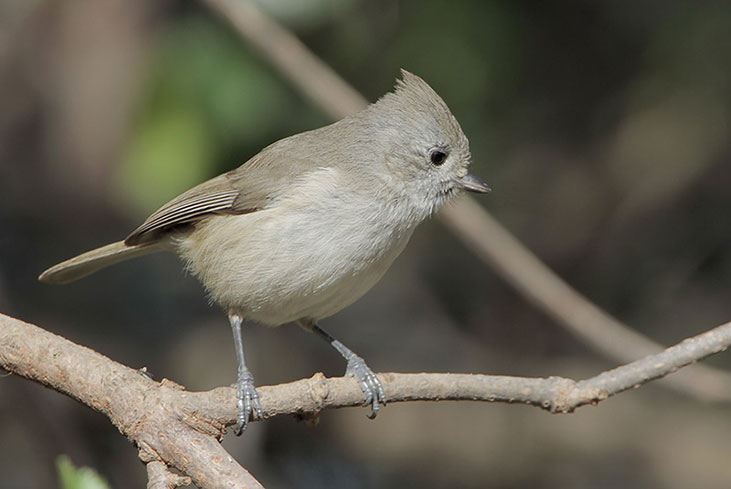
Scientific name: Baeolophus inornatus
Size: 5.75 inches
Habitat: Open oak savannahs and park-like habitats.
The Oak Titmouse is a sparrow-sized, crested bird with plain gray plumage. This species is such a plain-looking bird, it’s lack of field marks might be the best way to identify it!
Oak Titmice don’t have any markings, but they do show a hint of brown on their underparts and on their back. They also have fairly short wings, a medium-length rectangular tail, and beady black eyes.
These friendly little birds like to move around in pairs or small flocks that constantly make chattering calls as they forage. They inspect branches and use their stout, stubby bill to pick up bugs and seeds.
Related: What kinds of seeds do birds eat?
Oak Titmice can forage on the ground and also like to eat acorns and other nuts. These little birds are common in many areas of their range and are regulars at bird feeders.
The Oak Titmouse is mostly restricted to California, but some also live in southern Oregon and in northern Baja California.
Juniper Titmouse
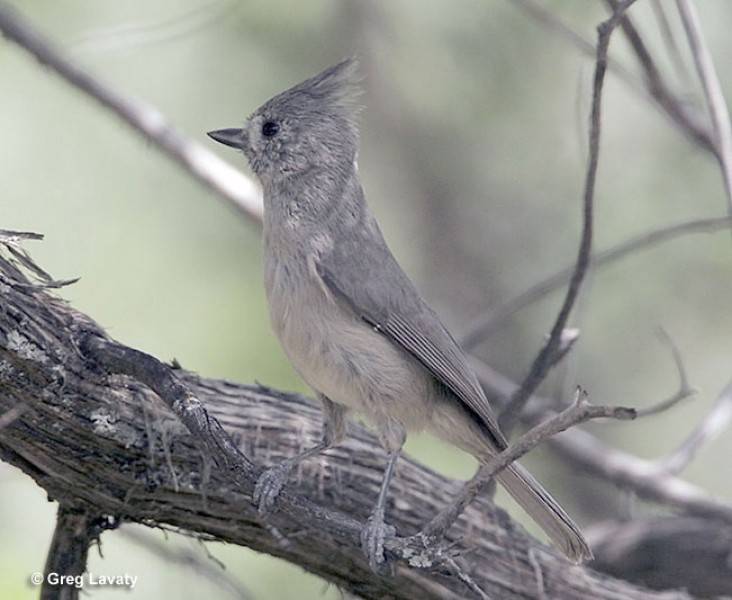
Scientific name: Baeolophus ridgwayi
Size: 5.75 inches
Habitat: Juniper woodlands and similar semi-open vegetation.
The Juniper Titmouse is a sparrow-sized, plain gray bird with a perky little crest. This bird and the Oak Titmouse used to be considered the same species, the aptly named “Plain Titmouse”.
Juniper Titmice are primarily plain gray without spots or any other markings. They are slightly darker above, have fairly short wings, a medium-length rectangular tail, and beady black eyes.
These cute little birds like to move around in pairs or small flocks, and make lots of little chattering vocalizations. They inspect pine needles and branches, and snatch bugs and seeds with their stout, stubby beaks.
Juniper Titmice can also forage on the ground for similar food items, especially seeds. These birds are common in most parts of their range, and can also visit bird feeders.
The Juniper Titmouse mostly lives in Nevada, Utah, Colorado, New Mexico, and Arizona. Some also range into southern Oregon, western Oklahoma, and the western edge of Texas.
Tufted Titmouse
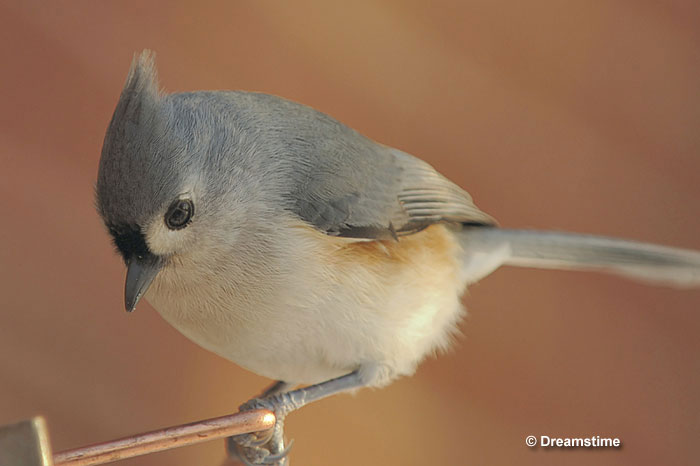
Scientific name: Baeolophus bicolor
Size: 6.5 inches
Habitat: Deciduous oak and maple woodlands, parks, and residential areas with lots of trees.
The Tufted Titmouse is a pretty, crested bird a little bit larger than a sparrow. It is blue-gray above, pale gray or whitish below, and has orange flanks. This species also has a little bit of black just above its stout dark beak, and a white face with beady black eyes.
Both sexes of the Tufted Titmouse look the same and juveniles look similar but are paler than adult birds.
This endearing bird is usually heard before it pops into view. As a small group of Tufted Titmice move through the trees, one or more whistles a repeated vocalization that sounds like, “peter peter peter”.
While foraging, they like to search foliage and branches for insects, berries, and seeds. The Tufted Titmouse also likes to visit feeders to pick up sunflower seeds, bits of peanuts, and feed on suet.
This handsome bird is common in most of the eastern USA and also occurs in southernmost Canada.
Black-crested Titmouse
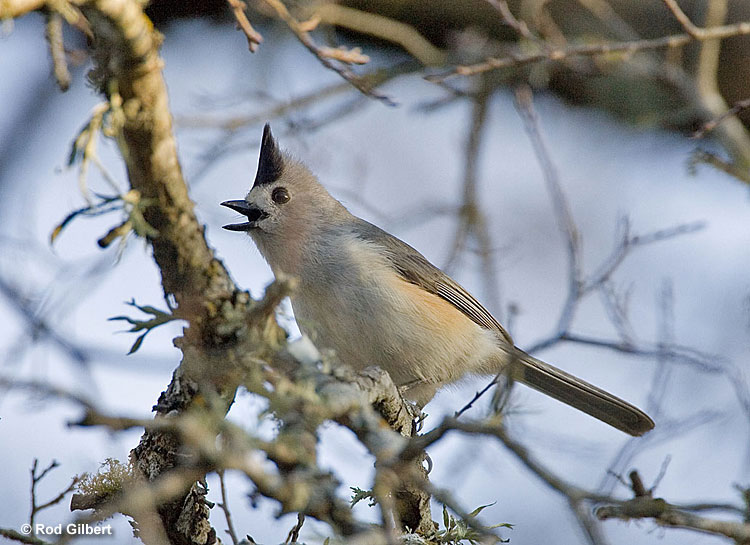
Scientific name: Baeolophus atricristatus
Size: 6.5 inches
Habitat: Arid and subtropical woodlands, parks, brushlands, and other open woodland habitats.
The Black-crested Titmouse is a striking, crested bird a bit bigger than a sparrow. This species is blue-gray above, has pale gray or whitish underparts, and orange sides. It also has a prominent black cap that extends up the front part of its crest.
This black patch contrasts with the bird’s white front. It also has a stubby dark beak, and beady black eyes on a white face.
Both male and female Black-crested Titmice look alike. Juveniles look similar but are paler and don’t have any black on their head.
Like its close relative, the Tufted Titmouse, the Black-crested Titmouse is a vocal bird that makes a similar, whistled, “peter peter peter peteer peter” call.
Small groups of these birds inspect leaves and branches for bugs, berries, and seeds. They also come to feeders for seeds, suet, and nuts.
The Black-crested Titmouse is a common species in Texas, a small area of western Oklahoma, and northeastern Mexico.
Bridled Titmouse
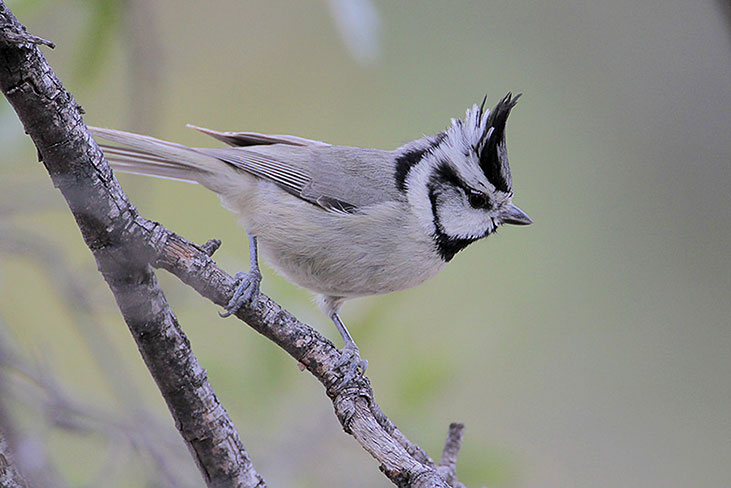
Scientific name: Baeolophus wollweberi
Size: 5.25 inches
Habitat: Open oak and pine-juniper woodlands in mountainous areas.
The Bridled Titmouse is a small, sparrow-sized, gray bird with a bold black and white face, and a perky crest. This bird is darker gray above, paler gray below, and has a black throat.
It also has a bold black line that goes back from its eye, black on the back edge of its face, and a bit of black at the edge of its gray crest. Bridled Titmice have fairly short wings and a longish, rectangular, gray tail.
These cute little birds like to form small groups that roam through high elevation woodlands with warblers and other small birds. They inspect leaves and branches for larvae, insects, and the occasional seed.
They also feed on acorns but may actually peck into the nut to find larvae more than to feed on the nut itself.
We find the Bridled Titmouse in the mountains of southern Arizona and adjacent southwestern New Mexico.
Carolina Chickadee
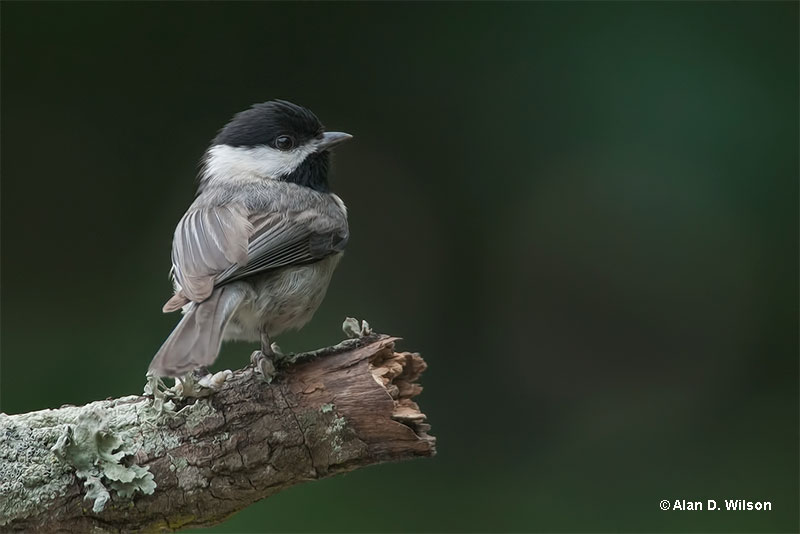
Scientific name: Poecile carolinensis
Size: 4.75 inches
Habitat: A variety of woodlands, parks, and residential areas with lots of trees.
Carolina Chickadees are one of the cuter birds in the southeastern USA. These warbler-sized birds have a rounded head with a smart black cap, white face patch, and a black throat.
They also have a stubby yet stout black beak, gray upperparts, pale gray and tan underparts, and a hint of white edging in their wings.
Both sexes of the Carolina Chickadee look the same and are probably impossible to tell apart.
Carolina Chickadees are bold birds that form small chattering flocks that can say their name, “chick-uh-dee dee dee”. They move through all heights of vegetation as they search for bugs, seeds, and berries, and often forage with other small birds.
These friendly birds are also regular at feeders, where they eat peanuts, seeds, and suet. We find these birds throughout the southeastern USA. They range north to Ohio and Pennsylvania, and range south to central Florida and eastern Texas.
Black-capped Chickadee
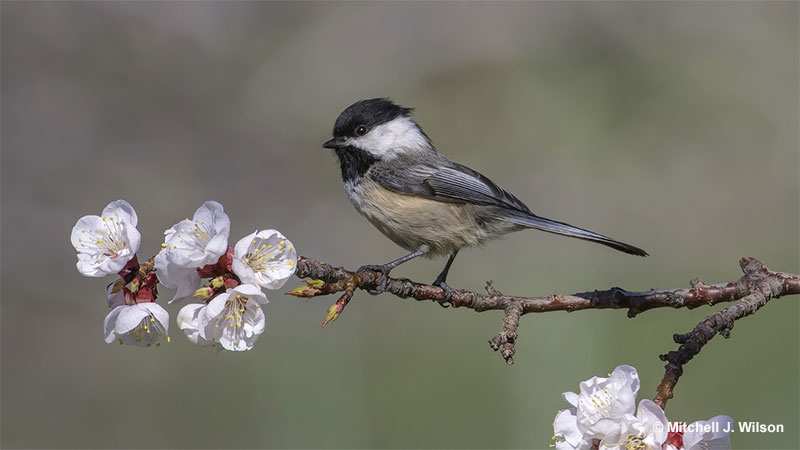
Scientific name: Poecile atricapilla
Size: 5.25 inches
Habitat: Various woodlands, parks, and residential areas with lots of trees.
Black-capped Chickadees are one of the best-known common backyard birds. As long as enough trees are present, small flocks of these adorable birds frequent the backyard.
Around the size of a warbler, Black-capped Chickadees have a black cap, white face patch, and black throat. They also have a small, stout black bill, gray upperparts, and pale gray underparts with tan flanks. These birds also show noticeable white edging in their wings.
Black-capped Chickadees are bold and inquisitive birds that move through trees and bushes in small, chattering flocks. They make whistling calls and often say their name, “chick-uh-dee dee dee”.
They feed on arthropods, seeds, and berries, and often forage with kinglets and other small birds.
These friendly birds are also common at feeders, where they eat peanuts, seeds, and suet. We find Black-capped Chickadees in Alaska, Canada, and the northern half of the USA.
Mountain Chickadee
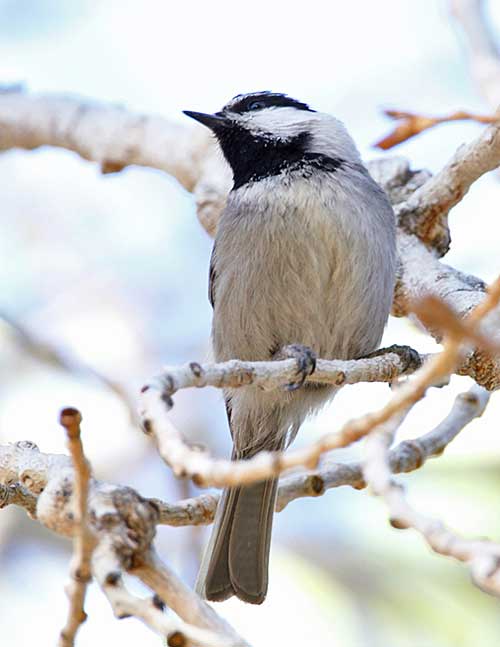
Scientific name: Poecile gambeli
Size: 5.25 inches
Habitat: Coniferous woodlands in mountainous areas.
Mountain Chickadees are warbler-sized birds with a rounded head, black cap, white eyebrow, large white face patch, and a black throat.
They have sharp, stubby bills, gray upperparts, and pale gray underparts. These cute little birds also have plain gray wings, and a hint of white edging in their tails.
Both sexes of the Mountain Chickadee look the same and probably can’t be told apart.
Like other chickadee species, Mountain Chickadees are bold birds that form small chattering flocks. They also have similar but harsher calls. This species forages in the foliage and branches of coniferous trees for insects and seeds. They also forage in mixed flocks with other small birds.
The Mountain Chickadee can come to feeders where it likes to eat suet and seeds. We find these handsome little birds in montane areas of the Rockies and other western mountain ranges from British Columbia to western Texas and northern Baja California.
Boreal Chickadee
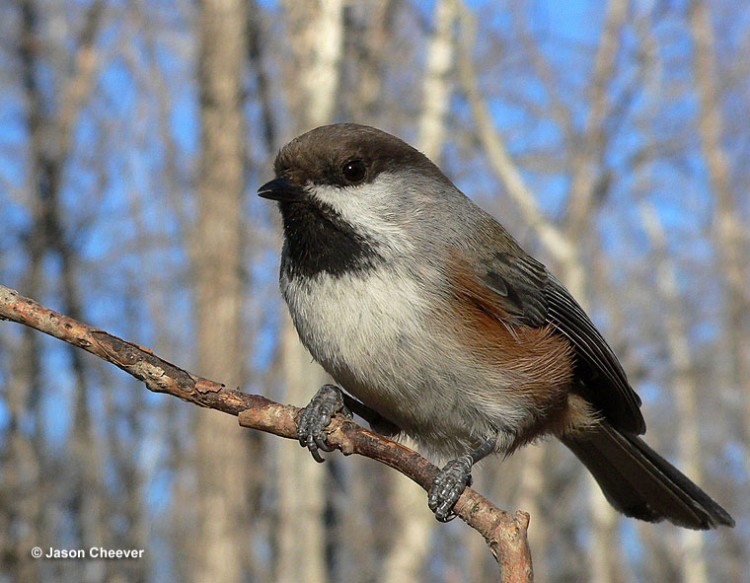
Scientific name: Poecile hudsonica
Size: 5.5 inches
Habitat: Boreal forests.
Boreal Chickadees are warbler or sparrow-sized birds with a dark brown cap on their rounded head. They also have a white and gray face patch, and a black throat.
These small birds have stubby, stout black beaks and gray upperparts with a brown back. Their underparts are pale gray with extensive pale brownish on their flanks and undertail, and this bird’s short, rounded wings are brown and gray.
Both sexes of the Boreal Chickadee look alike and can’t be told apart.
Boreal Chickadees are fairly common in their range but aren’t usually as numerous as Black-capped Chickadees. They sound sort of like Black-capped but make harsher, more wheezy calls and only make one “dee” call.
Small groups of Boreal Chickadees forage for insects and seeds with other small birds, and they can also come to feeders. We find Boreal Chickadees in Alaska, Canada, and some parts of the northern USA.
Chestnut-backed Chickadee
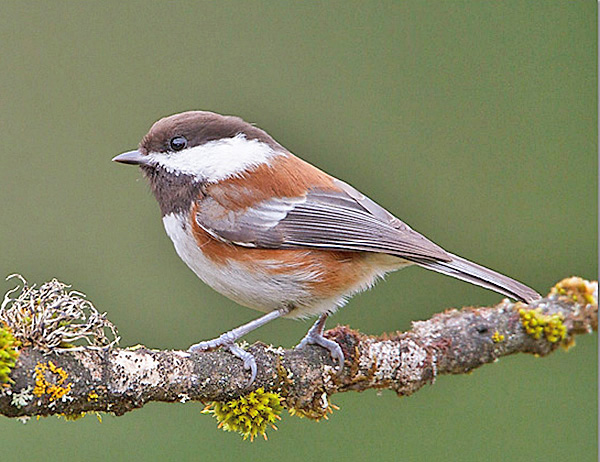
Photograph © Glenn Bartley.
Scientific name: Poecile rufescens
Size: 4.75 inches
Habitat: Wet coniferous forests in the Pacific Northwest.
Chestnut-backed Chickadees are small, warbler-sized birds with a deep, dark brown or black cap, black throat, and a bright white face patch.
They have stubby, sharp black beaks, chestnut brown on their back, and fine white edging on their dark wings.
This species also has rich chestnut brown on its flanks and undertail and a dark gray tail.
Like other chickadee species, both sexes of the Chestnut-backed Chickadee look the same and can’t be told apart.
Chestnut-backed Chickadees form small flocks that make buzzy and nasal-sounding calls as they forage with other small birds. They mostly feed on small insects but eat small seeds too, and can visit feeders for sunflower seeds, other types of seeds, and suet.
We find this species in humid coniferous forests and woodlands from Alaska to California and Idaho. Although it is a forest bird, in some places, this chickadee has also become adapted to residential areas.
Gray-headed Chickadee
Scientific name: Poecile cincta
Size: 5.5 inches
Habitat: Treeline vegetation with alder and spruce thickets.
Gray-headed Chickadees are sparrow-sized, fluffy songbirds with a small black throat patch, and a large white face patch. They also have a grayish-brown cap with a dark border, gray-brown back, and gray underparts with pale brown flanks.
Related: Common songbirds in the U.S.
This species has a stubby bill, white edging in its short, rounded wings, and white edging on its fairly long tail. It also makes nasal call notes similar to calls of other chickadees.
However, not many people get to hear them because, in North America, they only live in remote areas of northern Alaska and Canada!
Gray-headed Chickadees forage for insects and spiders in conifers and other plants. They also eat various seeds and, to survive the extreme winters that commonly occur in their range, can also eat carrion!
These birds may be locally common but occur at very low densities. They can forage in small groups but also join flocks of other small birds.
Mexican Chickadee
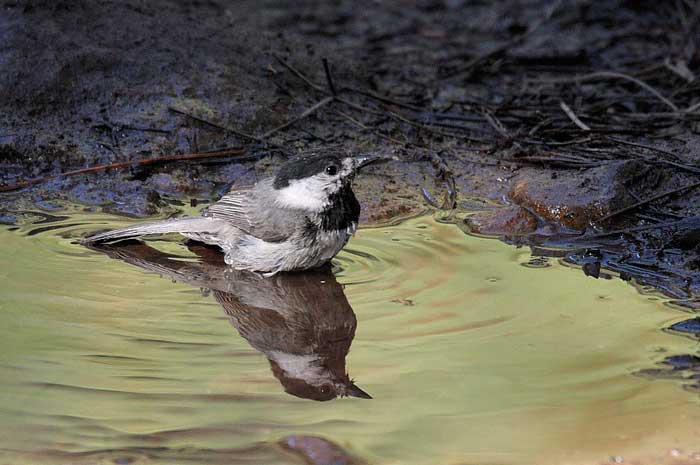
Scientific name: Poecile sclateri
Size: 5 inches
Habitat: High elevation coniferous forests.
Mexican Chickadees are warbler-sized birds with a jet black cap and a large, black throat patch. They also have a big white face patch, and a small, stubby beak.
This species has grayer plumage than other chickadees and always has dark gray sides. It doesn’t have any tan or brown coloration, and only has a bit of white edging in its short, rounded wings.
As with other chickadees, male and female Mexican Chickadees look the same and can’t be told apart.
Like other chickadees, they also forage in flocks, almost always with other small birds like kinglets, warblers, nuthatches, and other species. As they forage, we can often pick out the buzzy and hissing calls that this chickadee species makes.
Mexican Chickadees pick spiders and insects from foliage and branches. They rarely come to feeders, and most live in the Mexican highlands. In the USA, this species only occurs in high elevations in southeastern Arizona.


